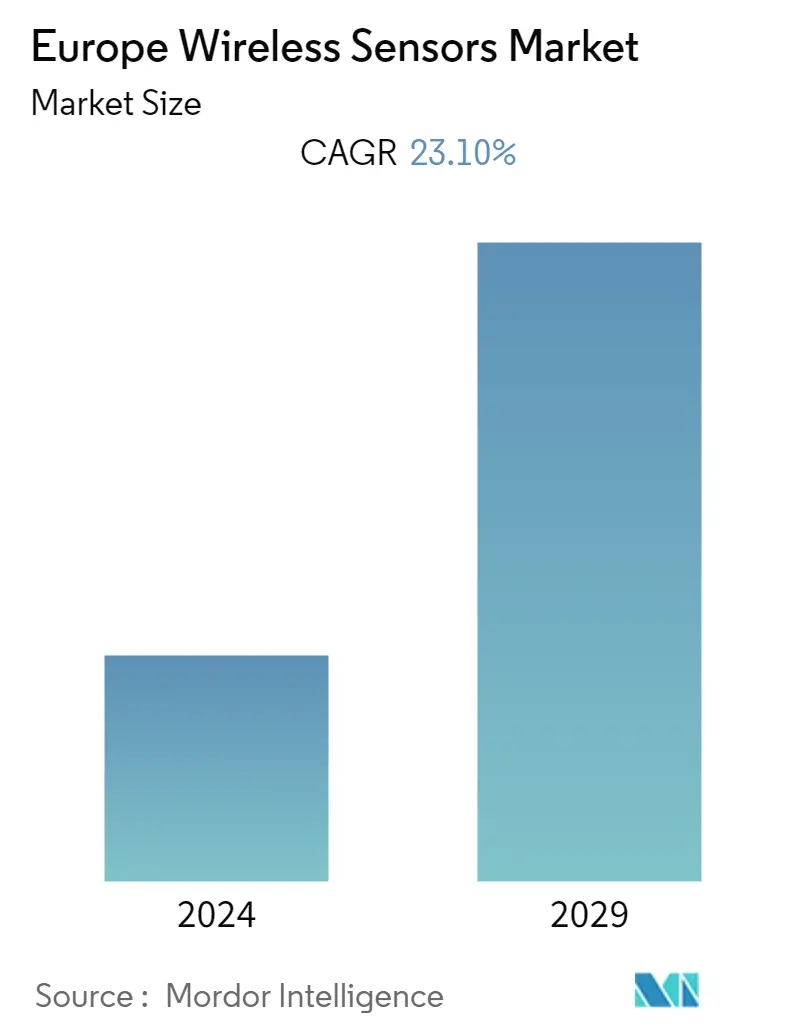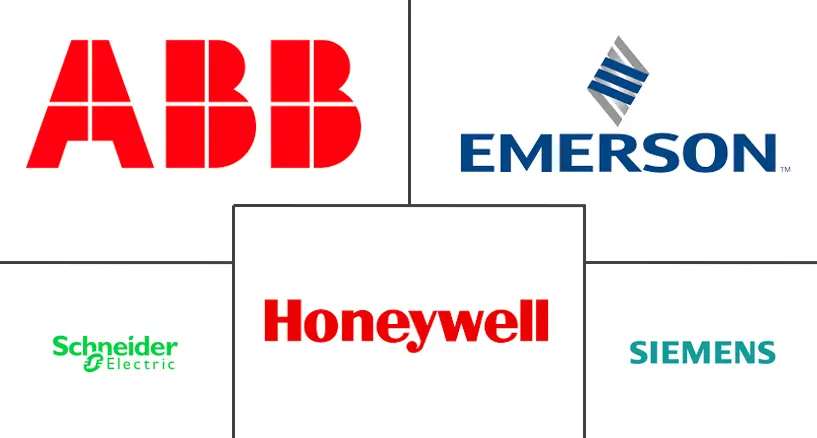Market Size of Europe Wireless Sensors Industry

| Study Period | 2019 - 2029 |
| Base Year For Estimation | 2023 |
| Forecast Data Period | 2024 - 2029 |
| Historical Data Period | 2019 - 2022 |
| CAGR | 23.10 % |
| Market Concentration | Medium |
Major Players
*Disclaimer: Major Players sorted in no particular order |
Europe Wireless Sensors Market Analysis
The European wireless sensor market is expected to register a CAGR of 23.1% during the forecast period (2021 - 2026). The growth in Industry 4.0 with the COVID-19 pandemic on the global scale has been acting as a catalyst that pushed the development of intelligent wireless sensors that help improve energy consumption with a high level of efficiency in the region. The growing range of pressure applications in industries contributes to developing single devices that can handle a range of pressures. Such devices are developed to simplify product designs, accelerate time to market and reduce sensory inventory costs of industrial manufacturers.
- The growth of the wireless sensors market is driven by the application in the various end-user industries. Manufacturers invest in R&D activities to improve the accuracy and reliability of wireless sensors. Wireless sensors are used for data monitoring and other similar functions and in building automation, military and defense, and other industries, like food and beverage and material handling.
- The key drivers influencing the wireless sensors market are the increasing need for new renewable energy development, energy sources, and other rapid technological advancements in the United Kingdom. They are also a vital component in smart grids for remote monitoring of transformers and power lines where they are put into service to monitor line temperature and weather conditions.
- Europe, which houses most automotive manufacturers, is expected to retain a substantial share in the market. The abundant availability of raw materials and the low establishment and labor costs have helped companies establish their manufacturing operations in the Asia-Pacific. It is expected that the vendors, to create an advantage of the first mover in technology transitioning, may adopt this evolution and invest in R&D according to their strategic vision.
- Many retailers and grocery stores are using wireless sensors on the floor to help employees create positive experiences for customers. Wireless push sensors can help the shoppers to indicate when cleaning is needed. Wireless air temperature devices are also assisting the superstores in monitoring refrigerators and non-cold merchandise simultaneously.
- Further, the energy and power sector has created an essential demand for wireless sensors in industrial applications. As energy conservation is increasingly important to reduce power consumption and its associated costs, accurate wireless sensors are required with appropriate wireless technologies helpful for testing devices for diesel truck emissions, wind engineering, wind energy systems, concerning new building design aerodynamics, ocean research, high-altitude weather research balloons, water pollution devices, smokestack mercury sampling, and atmospheric studies.
Europe Wireless Sensors Industry Segmentation
The study characterizes the wireless sensors market based on the type of wireless sensors, the end-user industry, and the country. Wireless sensors are measurement tools for monitoring and recording the physical conditions of the environment. They are equipped with transmitters that convert signals from process control instruments into a radio transmission. These sensors have various applications in numerous sectors, such as automotive, healthcare, aerospace, etc. These have formed the part of the study in considering the end-user industry estimation. The scope of the study is currently focused on key regions, such as the United Kingdom, France, Germany, etc. Further, to arrive at the overall market projections, the study analyzes the impact of COVID-19 and the investment scenario and other macro-economic factors.
| By Type | |
| Pressure Sensor | |
| Temperature Sensor | |
| Chemical and Gas Sensor | |
| Position and Proximity Sensor | |
| Other Types |
| By End-user Industry | |
| Automotive | |
| Healthcare | |
| Aerospace and Defense | |
| Energy and Power | |
| Food and Beverage | |
| Other End-user Industries |
| By Country | |
| United Kingdom | |
| Germany | |
| Italy | |
| France | |
| Rest of the Europe |
Europe Wireless Sensors Market Size Summary
The European wireless sensors market is experiencing significant growth, driven by advancements in Industry 4.0 and the increasing demand for energy-efficient solutions. The COVID-19 pandemic has further accelerated the development of intelligent wireless sensors, which are crucial for enhancing energy consumption efficiency across various sectors. These sensors are being integrated into a wide range of applications, including building automation, military and defense, and industries such as food and beverage and material handling. The automotive sector, in particular, is witnessing a surge in demand for wireless sensors due to the rise of electric vehicles and the need for advanced safety features. This trend is supported by technological innovations like wireless charging and head-up displays, which are becoming integral to modern vehicles.
The market is characterized by a competitive landscape with multiple vendors offering innovative wireless sensor solutions. Companies are focusing on expanding their customer base and enhancing product offerings to maintain a competitive edge. The energy and power sector is a significant contributor to the demand for wireless sensors, as they play a vital role in smart grids and energy conservation efforts. Additionally, the Internet of Things (IoT) solutions market is growing rapidly in Europe, providing lucrative opportunities for wireless sensor applications in various domains such as smart agriculture, asset tracking, and smart street lighting. The market's growth is further supported by strategic collaborations and technological advancements, ensuring a robust and dynamic industry environment.
Europe Wireless Sensors Market Size - Table of Contents
-
1. MARKET INSIGHTS
-
1.1 Market Overview
-
1.2 Industry Value Chain Analysis
-
1.3 Industry Attractiveness - Porter's Five Forces Analysis
-
1.3.1 Bargaining Power of Suppliers
-
1.3.2 Bargaining Power of Consumers
-
1.3.3 Threat of New Entrants
-
1.3.4 Threat of Substitutes
-
1.3.5 Intensity of Competitive Rivalry
-
-
1.4 Technology Snapshot
-
1.5 Assessment of the Impact of COVID-19 on the market
-
-
2. MARKET SEGMENTATION
-
2.1 By Type
-
2.1.1 Pressure Sensor
-
2.1.2 Temperature Sensor
-
2.1.3 Chemical and Gas Sensor
-
2.1.4 Position and Proximity Sensor
-
2.1.5 Other Types
-
-
2.2 By End-user Industry
-
2.2.1 Automotive
-
2.2.2 Healthcare
-
2.2.3 Aerospace and Defense
-
2.2.4 Energy and Power
-
2.2.5 Food and Beverage
-
2.2.6 Other End-user Industries
-
-
2.3 By Country
-
2.3.1 United Kingdom
-
2.3.2 Germany
-
2.3.3 Italy
-
2.3.4 France
-
2.3.5 Rest of the Europe
-
-
Europe Wireless Sensors Market Size FAQs
What is the current Europe Wireless Sensors Market size?
The Europe Wireless Sensors Market is projected to register a CAGR of 23.10% during the forecast period (2024-2029)
Who are the key players in Europe Wireless Sensors Market?
Honeywell International Inc., Emerson Electric Co., Schneider Electric, Siemens AG and ABB Ltd. are the major companies operating in the Europe Wireless Sensors Market.

